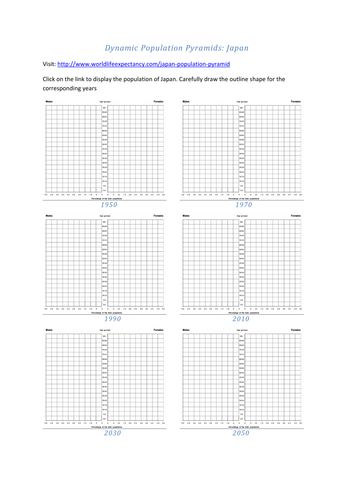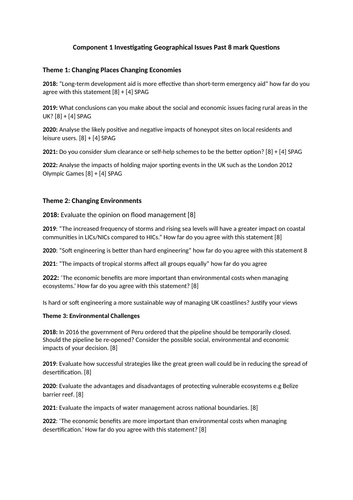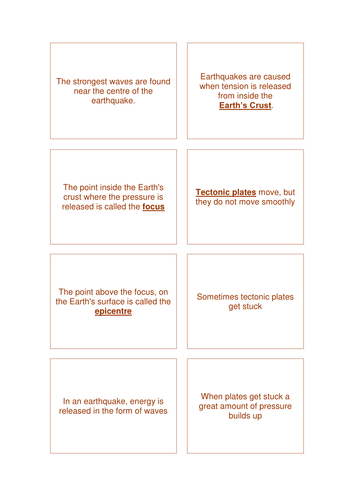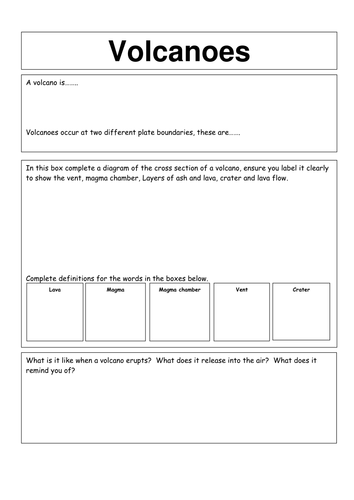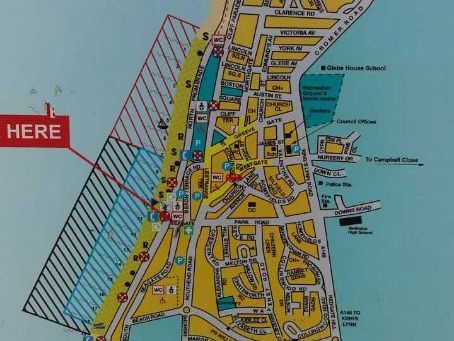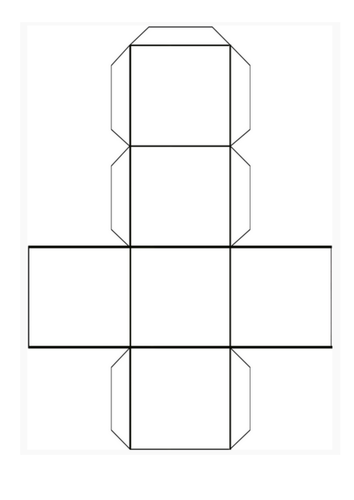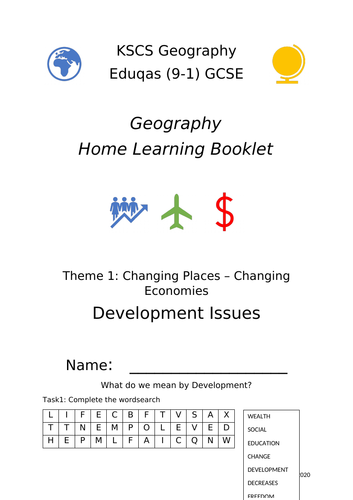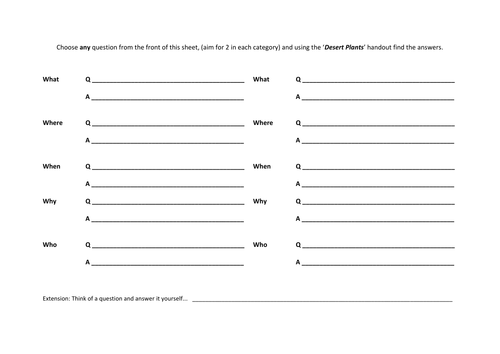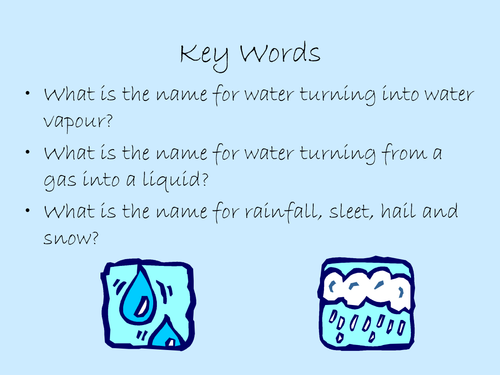46Uploads
248k+Views
136k+Downloads
All resources

Dynamic Population Pyramids: Japan
Students draw the outline shape of Japan's population structure as it changes over time as it moves through stages of development and the demographic transition model. (Requires access to ICT / Internet)
The teachers' version could easily be laminated and converted into a card sort as a starter plenary activity etc for pupils to place in the correct order.

Past 8 Mark Questions Eduqas Geog B 2018 - 2022
The Past 8 Mark Questions from Eduqas Geog B 2018 - 2022

The Niigata Earthquake
Resources on the 2004 Japanese Earthquake in Niigata for students to identify the causes of an Earthquake. To classify the effects of the earthquake.

A3 Water management sheet (GCSE Geography B Eduqas)
An A3 sheet to help structure notes on the Eduqas topic of Water Management from the Eduqas Geography B.
Useful Revision summary

Earthquakes & Avalanches & Volcanoes
Three data capture sheets for research on Volcanoes, Avalanches and Earthquakes, useful for both KS3 and KS4; the worksheets can be used as a writing frame for video notes, Internet research or Library research.

Hunstanton Clone Town Survey (Virtual Fieldwork)
Geographical Investigation: Does Hunstanton need its own identity?
A clone town survey identifies the number of independent shops that are remaining in the UK’s high streets, compared to chain stores.
Use Google Street View and the sheets to calculate the clone town score for Hunstanton. Is Hunstanton a clone town?
Is Hunstanton a good example of a sustainable community?

Plate tectonics cube display (4 types of plate margin)
A Geography display that shows the different types of plate boundaries/margins. (destructive, constructive, collision and conservative)
The aim is for pupils to draw 4 labelled diagrams on the blank template of the four types of plate margins.
Pupils then cut out the cube template, fold and stick together and they can then be hung up as a display using string.... The more colourful the better! They are also good for revision aids!
*Please be sure to instruct your pupils to draw their diagrams the correct way round so the diagrams can be read when the cube is glued together!

Does Fairtrade help improve peoples' lives? (KS3 Geography)
As part of Fair trade Fortnight 21st February to 6th March 2022. These KS3 activities consider the coffee supply chain, general features of Fair trade before focusing on 6 Fair trade case studies / products from different countries the story of the farmers and local community impacts.
Ultimately students decide: does Fair trade help improve peoples’ lives?

A3 Fieldwork Summary Sheet
An A3 Summary sheet following up on Urban Fieldwork to City Centre
Useful for Geographical enquiry Questions such as How far does Peterborough meet the criteria for sustainability (Egan’s Wheel).
Useful if you print in colour , as the sections are colour coded to match the Enquiry Process.

Tropical Rainforests Year 7 self guided activities
A series of 10 PowerPoint presentations / activities on Tropical Rainforests.
developing geographical understanding & literacy skills. (Yr 7 KS3)
The activities were designed for remote learning and can be either be self-guided, taught individually or in a group.
Ecosystems & Structure
Biomes & adaptations
Climate graphs
Design own plant
Food Chains & webs
Amazon Tribes
Impacts of deforestation
Sustainability
Future of TRF’s
Value of TRF’s

Development Issues Home Learning Booklet
Eduqas 9-1 Changing Places - Changing Economies
Development Issues
Tasks and activities to consolidate learning for the Development topic.
14 pages of content to support home learning or in the classroom

GCSE Climate Change
A PowerPoint and accompanying booklet of activities and lessons based around Eduqas Changing Environments: Climate change topic.
Pupils will by completing the activities be able to say how climate change is affecting wildlife in the Arctic, how warmer temperatures affect the Arctic food chain, how volcanic eruptions affect climate.
They will be able to explain how climate change can affect peoples health in Africa, know how climate change might affect Australia, state how climate change affects where people live. The natural and human causes of climate change. Comment on the reliability of the evidence for climate change, know how climate change can affect tourism. Know the 3 approaches to creating a low carbon future in the UK and know how individuals and governments can reduce the risk of climate change.

The Chilean Earthquake 2015
A PowerPoint, newspaper article, card sort and data capture sheet (Facts, Causes, Effects and Responses) on The Chilean Earthquake of 2015.
Learning Objective: to understand that Hazard resistant design and preparation procedures (& evacuation) are key factors in reducing the effects i.e deaths of high magnitude earthquakes.
Students work towards answering the question: why did only 13 people die in an 8.7 magnitude earthquake? Higher level students can read the newspaper article and classify the statements in to facts, causes, effects, responses, or you could use the card sort.

OCR Geography B (Enquiring Minds) Topic 1 Global Hazards 1.1 Weather
OCR Geography B (Enquiring Minds) Topic 1 Global Hazards 1.1 How can weather be hazardous?
47 slide PowerPoint activities, films and resources covering:
The Global Circulation system
Climatic zones
Extremes of weather in contrasting countries
Distribution and frequency of tropical storms
El Nino ans La Nina
Drought and desertification case study
Use of GIS and Geographical Skills

Deserts & Plant Adaptations
Pupils will be able to enquire and ask / research a series of questions, using a data capture sheet. Pupils will know what the definition of a desert is and name an example of at least one and know how desert plants are adapted to their environment.
The resources are differentiated so that higher ability pupils can ask further / higher level questions and the structure of the enquiry sheet can suggest/prompt lower ability pupils for answers. the plenery is a fun idea and it works well with year 8 pupils... surprising how much they can recall.

D-Day Assembly
A brief overview of D-Day and reflecting on the 80th Anniversary suitable for secondary aged pupils 11-18.

Eduqas Geog B Revision guide
A variety of activities to support the Eduqas Geography B Spec.
Useful for Exam preparation and revision.
Including elements of topics including: Tropical rainforests, Semi-arid environments, global atmospheric circulation, Rivers, Global Cities & Development

Three types of Rainfall
The objectives of the Powerpoint, animation, video and various worksheets are to identify the three different types of rainfall (frontal, convectional and relief). To investigate and understand the mechanisms behind the different types of rainfall, and to identify and explain the link between areas of high altitude and relief rainfall.

